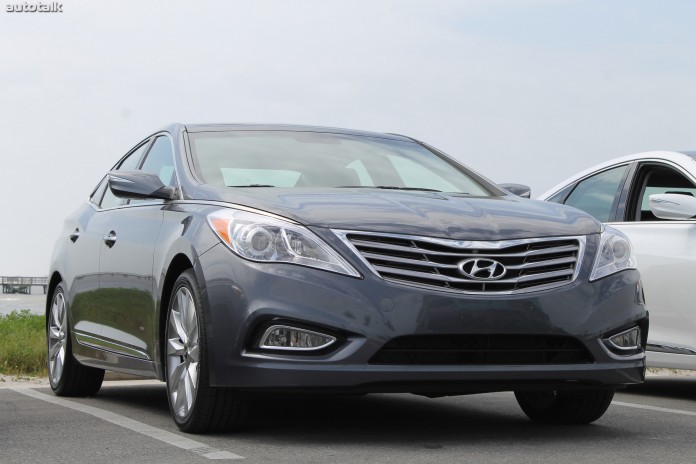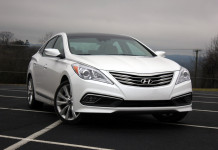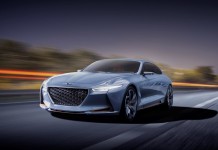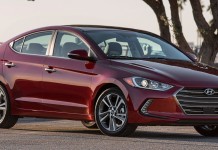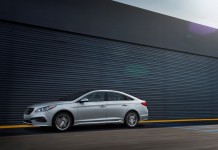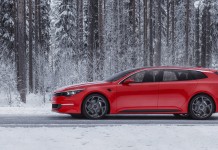In 2008, Hyundai shocked the automotive world by releasing a car that was not only not-small, but not low powered and full of cloth seats. Instead, it was strong, luxurious, big and given the name Genesis. In sedan form, the car went head first after the likes of the BMW 5-Series, Lexus GS and Audi A6 and did so with a big V8 and rear wheel drive. If a driver was in the mood, the cushy couch could be flung completely sideways in a cloud of white smoke and noise with nothing but scorched concrete left behind. Given its split personality (though extremely well-managed), the Genesis Sedan has been placed in the category of sports luxury and new editions such as the 5.0 R-Spec have pushed the car down that path even more so. So far, not to many people have been complaining but even still, Hyundai felt as if they had left the true luxury sedan buyer without an option. What if the consumer doesn’t want to hurl their leather wrapped love chair towards an apex at triple digit speeds? What if they would rather listen to quiet jazz with their sweat heart on an endless journey to the other end of the nation? For the 2012 model year, Hyundai has pulled the covers off their answer that very question and it’s called the Azera.
The Azera isn’t a new name for Hyundai as it’s existed in some form since the 1980s when the automaker introduced the Grandeur full size sedan to the South Korean market. That front drive four door was a joint effort with Mitsubishi Motors that lasted for two generations until Hyundai built their own car in the late 1990s. For its third time out, the brand got the courage to send a version to the United States, giving it the name XG350. In 2006, the fourth iteration of the Grandeur was born and with it, the first time the Azera name landed on a Hyundai. Marketed as such in the U.S., the brand had a proper flagship that was not only filled with durability, but luxury to boot. Aimed directly at taking away sales from Toyota’s Avalon and Buick’s LeSabere, the Azera modeled the philosophy of those silent luxury land cruisers: soft suspension, front wheel drive and six cylinder power. Despite its quiet operation, comfy seats, smooth power and excellent warranty, the car could not seem to grab the attention of American buyers the way it’s Korean version does in its home land. For the fifth attempt and 2012 model year, Hyundai is making one more push to break out with the Azera and stop the American public from simply saying, “I didn’t even know about that car.” In order to find out more for ourselves, we traveled to the breezy coast of New Orleans to get behind the wheel.
According to Hyundai, the Azera is “an aspirational model for move-up sedan buyers.” Its placement in their model line up is in between the midsize Sonata and rear drive Genesis Sedan. Other manufactures have produced such a vehicle for a special demographic and thus, the Azera has competition in the likes of the Toyota Avalon, Nissan Maxima, Buick LaCrosse and Ford Taurus. It carries similar dimensions with its rivals: a 193.3 inch length, 73.2 inch width and a class-leading 123.3 cubic feet of total interior volume. For the 2012 model year, everything from the chassis, transmission, engine, exterior and interior is new. To keep things for buyers simple, there are just two trims to purchase with two set prices. Base MSRP for the Azera is $32,000 without freight and includes standard features such as leather seating, heating for the front and rear, navigation via a seven inch touchscreen display, back up camera, BlueLink Telematics and bluetooth device pairing. For $4,000 extra, the Technology Package adds 19 inch wheels, a panoramic sunroof, HID headlamps, power rear sunshade, rear side window sunshades, an Infinity supplied stereo with subwoofer, power steering wheel with tilt and telescope feature, memory seating with cooling for the front, parking assist sensors and interior ambient lighting. Compared to the 2011 model, the new car’s base price did jump but in all honesty, it did rightfully so. In order to get the massive amount of stuff packed into the 2012 Azera, last years car would have to have added pricey options that would have brought the MSRP to similar levels.
With the sun shining above, we took the reigns of a Smoke Grey Metallic Technology Package and took off to gobble up the broken asphalt of New Orleans. At first, the Azera’s outward appearance finally grabs actually attention. Unlike the last generation, the 2012 uses Hyundai’s now quintessential Fluidic Sculpture Design vision and does so rather well. The body lines took inspiration from aircraft engineering with the target set on adjectives such as “authoritative”, “elegant” and “powerful.” Restraint was used in comparison to the other Fluidic Hyundais such as the Genesis Coupe and Veloster; a rather intelligent move considering the Azera’s key demographic. The final results could be nothing more than just handsome with a Sonata-like front end and subtle, wide rear fenders. In profile view, the sedan has just enough rake in its body that it appears almost sporting while the tapered rear end with wrap-around tail lamps finish off the overall mature package. Perhaps a little more innovation could have gone into the front because more times than not, we thought a local’s Sonata was an Azera until the side profile came into view.
When inside, the word handsome gets joined by delicate and modern. The dash and center console have been shaped to form a “Y” so that each front occupant gets their own personal space. The furthest left and right lines meet at the major center point in an elegant fashion and the car’s overall symmetry seems dead on. Getting behind the steering wheel, a driver will be greeted by simple but attractive analog dials that are beyond easy to read. The leather wrapping of the shift knob, steering wheel and other trim bits feel supple and well made while the materials used for the rest of the car are not just an afterthought. A big gripe we have with the Genesis Sedan doesn’t exist in the Azera as the wheel telescopes plenty enough for a perfect driving position. It may be obtainable, but that position isn’t intuitive to achieve as the seat adjusters are oddly placed right below the A-pillars instead of on the seat. Other manufactures have done this before, but not often enough for it to be grab-and-go. Sitting on the right, a passenger gets plenty of leg room and the ability to easily change the radio station while the driver isn’t looking. In the Technology Package, that switch might not go on for too long as the Infinity stereo is crystal clear and ample enough for even the strictest audiophile. A quick flick of the large volume knob and push of the station buttons returns responsive requests, which is the same story for the standard navigation system. Offering real time weather, stock reports, sports scores and turn-by-turn direction, the colorful display is as easy to read as it is to use. The fact that the device is standard, even on the base car, is absolutely remarkable and unheard off even in the Azera’s segment.
As entertaining as the front may be, the rear is without a doubt the best place to be while inside the Azera. The cushioning used for the back seats can only be described as otherworldly and there’s so much space in front, above and alongside that it would be rather difficult to get not comfortable. A human body simply sinks to a point of full support and as long as the scenery is worthy enough, a back seat occupant could be peaceful for days. They won’t even notice when the driver mashes the throttle pedal wide open for a two-gear downshift on the highway. Besides the sudden and smooth increase of speed, neither will the driver as the Azera’s drivetrain is as flowing as its body lines. Powering the front wheels of all 2012 cars is just one engine and one transmission: a 3.3 liter V6 and six speed automatic. A member of the Lambda engine line that created the high-output Genesis 3.8, the smaller diplacement block is all-aluminum with dual overhead cams, variable valve timing and gasoline direct injection. Regarded as an Ultra Low Emissions Vehicle, the 3.3 uses neat items such as a variable intake system, sleeved cylinder bores, high pressure fuel lines and a roller timing chain. A high, 11.5:1 compression ratio helps the relatively small displacement six produce rather high figures of 293 horsepower and 255 lb-ft of torque on regular fuel. Straight line speed isn’t rocket ship, neck snapping fast but it is by no means slow. The Azera can flat-out hustle but does so in the most mature way possible that a driver would rather cruise at 75 rather than 135. Triple digit speeds can be had, but in a car like this, what’s the point? Power is one thing, but efficiency is now just as important and the big sedan should average 20 mpg in the city and 29 mpg on the highway. In our short time driving the Azera, we saw an average of 25 mpg: ample for a car of this magnitude.
Putting the throttle to the floor while at a stand still or low speeds in a front drive car with nearly 300 horsepower would normally result in hellacious torque steer, but in the Azera it was strangely absent. The drivetrain layout, suspension, steering and transmission’s shift patterns were specifically installed to reduce wheel tug as much as possible and it seems to have worked. With traction control off, there is enough mustard to spin the tires, but you won’t find yourself being steered into a tree. When a gear change is called upon, the Hyundai-built six speed auto does its business and then moves on; leaving no trace of what just transpired. This drivetrain is so glass smooth in all its workings, that there are no complaints about the lack of an optional engine/transmission choice. Aiding the motivation is the car’s chassis composed of an electric assisted steering rack and fully independent suspension. Featuring a dead-on-center default, the Azera drives straight as if laser guided. Slowing down for a corner is assisted with communicative brakes while the front strut and rear multi-link suspenders ensure stability. Not a corner carving beast like the Genesis, the Azera doesn’t wallow or flex; it just does things in a much softer manner.
It may be powerful, smooth, ergonomically superior and elegant looking, but the Azera isn’t perfect. Our biggest complaint came out due to simple but present road noise. With the stereo turned all the way down, wind, tire roar and pavement imperfections were simply too loud to be ignored. It’s an honest disappointment, especially considering the car’s segment which prides itself on quiet operations. Passenger comfort may still be out-of-this-world high, but the driver seat lacks the rear’s cushioning and went flat after a sustained period. These gripes can be fixed with simply engineering but one concern might not have the ability to be silenced as easily. The Azera is a solid luxury car will all the right ingredients but so is the Genesis Sedan. Base pricing for the rear drive car is in the low $30 grand range and its name is much better known in the United States market compared to the Azera. Hyundai is honestly taking a chance in order to see what a legitimate update can do for an otherwise alone car. Advertising is poored into the Sonata, Veloster, Elantra, Genesis and so on, but not the former flagship and that might need to change.
In February, large car sales in the United States were down. Numerous manufactures have simply ditched the segment to concentrate on crossovers, midsize sedans and compacts due to market demand but that doesn’t mean that the style should be killed off. When vehicles such as the Azera are put into the equation, the large car starts to make sense again as it does have the ability to be efficient, powerful, comfortable and affordable. There is no reason why luxury items such as cooled seats, navigation, rear sunscreens and real time stock reports have to be exclusive to expensive premium vehicles. There is also no reason why a luxury car has to double as a track blasting hot rod carving corners sideways. Maturity can exist in a car featuring perforated leather and a beautiful panoramic roof while a triple turbo quad supercharged dual V16 alcohol burning race derived engine doesn’t have to be used. The 2012 Hyundai Azera is rolling proof as it is smooth, elegant, easy to use, safe, reasonable, luxurious and reliable. It is, what the luxury cars of the past should have evolved into.

